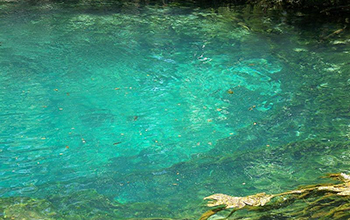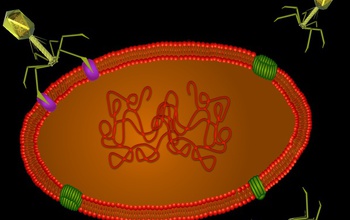搜索结果: 1-14 共查到“海洋科学 viruses”相关记录14条 . 查询时间(0.081 秒)

Ocean algae get 'coup de grace' from viruses--sometimes(图)
Ocean algae coup de grace viruses--sometimes
2020/9/25
Scientists have long believed that ocean viruses quickly kill algae. But new U.S. National Science Foundation-funded research shows that viruses often live in harmony with algae, and that they pr...

Scientists conduct first census of viruses and bacteria in Florida springs(图)
Scientists conduct first census viruses bacteria Florida springs
2020/6/12
Like oxygen, the Floridan Aquifer falls into the category of things we can’t see but also cannot live without.One of the largest and most productive aquifers in the nation, it provides drinking water ...

Algae-killing viruses spur nutrient recycling in oceans(图)
Algae-killing viruses nutrient recycling oceans
2019/10/23
Scientists have confirmed that viruses can kill marine algae called diatoms, but diatom die-offs near the ocean surface may provide nutrients and organic matter for recycling by other algae.Diatoms ar...

Surprising enzymes discovered in giant ocean viruses(图)
Surprising enzymes giant ocean viruses
2019/10/28
Results of a new NSF-supported study led by researchers at the Woods Hole Oceanographic Institution and Swansea University Medical School increase our knowledge of viruses -- in the sea and on land --...
Study Shows Large Variability in Abundance of Viruses that Infect Ocean Microorganisms
Large Variability Viruses Infect Ocean Microorganisms
2016/2/22
Collecting and re-examining more than 5,600 estimates of ocean microbial cell and virus populations recorded over the past 25 years, researchers have found that viral populations vary dramatically fro...
The last 10–15 years have seen major changes in our views of marine planktonic food webs, primarily from the realization that prokaryotic microorganisms and small eukaryotes are responsible for a sign...
At abundances routinely greater than 10 million particles per milliliter, viruses are the most numerous biological entities in the oceans. To put the sheer abundance of marine viruses in context, we n...

The 'intraterrestrials': New viruses discovered in ocean depths(图)
intraterrestrials New viruses ocean depths
2015/3/25
The intraterrestrials, they might be called.Strange creatures live in the deep sea, but few are odder than the viruses that inhabit deep ocean methane seeps and prey on single-celled microorganisms ca...
Viruses hijack deep-sea bacteria at hydrothermal vents
Viruses hijack deep-sea bacteria hydrothermal vents
2014/5/13
ANN ARBOR—More than a mile beneath the ocean's surface, as dark clouds of mineral-rich water billow from seafloor hot springs called hydrothermal vents, unseen armies of viruses and bacteria wage war.
Effect of viruses and protists on bacteria in eddies of the Canary Current region (subtropical northeast Atlantic)
Effect of viruses Canary Current region
2014/4/16
The effect of oceanic eddies on microbial processes, with emphasis on bacterial losses due to protists and
phages, was examined in the Canary Current region (subtropical northeast Atlantic) through t...
Viruses as mortality agents of picophytoplankton in the deep chlorophyll maximum layer during IRONAGES III
Viruses mortality agents picophytoplankton in the deep chlorophyll maximum layer IRONAGES III
2014/4/21
We report viral-induced mortality rates of the picoeukaryotic (two size classes) and prokaryotic (cyanobacteria Prochlorococcus and Synechococcus) phytoplankton during a cruise in the oligotrophic sub...
Distribution of viruses and bacteria in relation to diagenetic activity in an estuarine sediment
viruses bacteria sediment
2014/5/21
The distribution of viruses and bacteria was investigated in relation to bacterial sulfate reduction and total respiration (production of dissolved inorganic carbon, [DIC]) in a coastal sediment. Vira...
The abundance, distribution, and correlation of viruses, phytoplankton, and prokaryotes along a Pacific Ocean transect
abundance distribution correlation of viruses phytoplankton prokaryotes a Pacific Ocean transect
2014/5/26
Concentrations of virus-like particles (VLP), prokaryote-like particles (PLP), chlorophyll a, and zeaxanthin were determined at 9-12 depths (0-250 m) for each of 13 stations along a 3,800-km transect ...
Viruses causing lysis of the toxic bloom-forming alga Heterosigma akashiwo (Raphidophyceae) are widespread in coastal sediments of British Columbia, Canada
Viruses causing lysis toxic bloom-forming alga Heterosigma akashiwo Raphidophyceaewidespread in coastal sediments of British Columbia, Canada
2014/5/26
Viruses that infect and cause lysis of the toxic alga Heterosigma akashiwo are abundant and widespread in the Strait of Georgia, Canada, and adjacent inlets during the summer months when blooms of thi...

